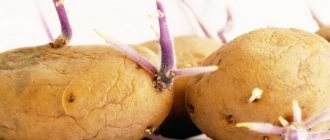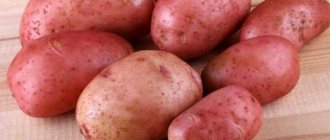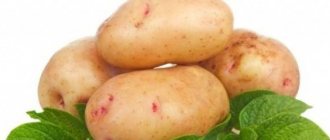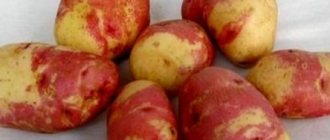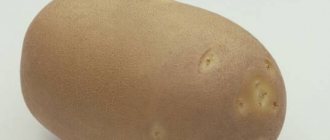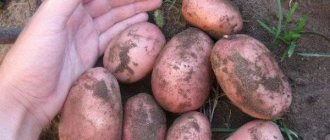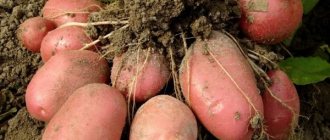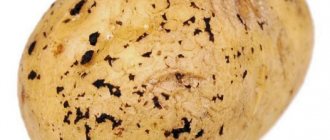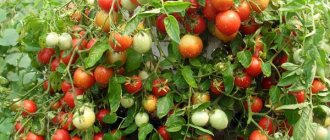Description of the variety
| Variety name | Margarita |
| general characteristics | mid-late table Dutch potato variety with regular oval-shaped tubers |
| Maturation period | 80-100 days |
| Starch content | 14-16,5% |
| Weight of marketable tubers | 90-150 gr |
| Number of tubers in a bush | 7-12 |
| Productivity | 300-400 c/ha |
| Consumer qualities | good taste, suitable for preparing any dishes |
| Keeping quality | 96% |
| Peel color | red |
| Flesh color | cream |
| Preferred Growing Regions | Central |
| Disease resistance | highly resistant to scab, potato blight, mottled mosaic, nematodes |
| Features of cultivation | standard agricultural technology |
| Originator | AgroPlant (Netherlands) |
Potato “Margarita” is a medium-late variety; the development period from the appearance of the main sprouts to technical maturity ranges from 80 to 100 days. Young potatoes can be eaten at the stage of conditional maturity , when the root crops grow to normal sizes, the skin is thin and lagging.
Reference. Mid-late and late potato varieties are stored better and longer than other varieties and contain more starch.
You don’t have to be afraid to keep the potatoes in the ground. You can plant Margarita without germination.
The history of the origin of the Margarita potato variety
The Margarita potato variety was developed by Dutch breeders by crossing the Asonia and Saga varieties.
In 2015, the variety was included in the State Register of Russia.
The table presents data on the mass of marketable tubers (grams) of different varieties:
| Name | Variety |
| Nikulinsky | Late ripening |
| Cardinal | Late ripening |
| Rocco | Late ripening |
| Picasso | Late ripening |
| Borovichok | Early ripening |
| Elmundo | Early ripening |
| Felox | Early ripening |
| Bellarosa | Early ripening |
| Karatop | Extra early |
| Zhukovsky early | Extra early |
| Farmer | Extra early |
| Minerva | Extra early |
| Sorcerer | Mid-late |
| Mozart | Mid-late |
| Grenada | Mid-late |
| Melody | Mid-late |
| Giant | Mid-early |
| Tuscany | Mid-early |
| Purple Haze | Mid-early |
| Openwork | Mid-early |
Appearance
The shape is regular oval.
Dimensions - about 8 cm in length, weight - from 90 g to 150 g. Peel - smooth, dense, dark red, crimson in color. Small eyes have an average planting depth; there are few of them on the peel. The pulp is light yellow (cream) in color, the amount of dry matter is increased - up to 19%. Starch content - up to 16.5% - average amount .
Bush of stem type, spreading, tall. “Margarita” is distinguished by the preservation of a persistent green bush when ripening; usually the bush turns yellow and falls at the beginning of ripening. The leaves are of a closed type, the shape is typical potato, the color is dark green, the size is large, the structure is wrinkled, there is no pubescence, the waviness of the edge is weak, they grow at intervals.
There are many flowers, the corolla is dark red or light purple and large in size.
Characteristics
Productivity
"Margarita" has a stable, abundant harvest, regardless of good weather conditions. in the Central region - on average up to 308 c per 1 hectare, which meets or exceeds the standards. The maximum yield is 400 centners per 1 hectare .
In the table below you will find this characteristic for different varieties presented on our website:
| Variety name | Productivity |
| Margarita | up to 400 c/ha |
| Santa | up to 570 c/ha |
| Tuleevsky | 400-500 c/ha |
| Kolobok | 450-600 c/ha |
| Ilyinsky | 180-350 c/ha |
| cornflower | 200-480 c/ha |
| Laura | 330-510 c/ha |
| Irbitsky | up to 500 c/ha |
| Sineglazka | up to 500 c/ha |
| Adretta | up to 450 c/ha |
| Alvara | 295-440 c/ha |
The marketability of tubers is about 98% . One plant produces many large tubers, but no small root crops. According to reviews from gardeners, tubers from 100 g are used for seeds, no less. According to some gardeners, up to 120 kg of potatoes can be harvested from 5 bushes.
Usage
Potatoes contain many useful substances, both raw and after heat treatment.
“Margarita” has a universal purpose, mainly used as food. The tubers do not become overcooked due to their low starch content; they are suitable for French fries, frying, and cooking for salads.
Taste qualities
The Margarita potato variety has excellent taste characteristics. Boiling potatoes in their skins helps preserve all nutrients, and baking them in coals or in the oven in their skins will preserve vitamins.
For people suffering from diabetes, potatoes should be consumed infrequently and soaked for 24 hours before cooking, this will remove the starch. In other cases, peeled potatoes are immediately subjected to heat treatment; water washes out a certain amount of useful microelements.
Advantages and disadvantages
Among the disadvantages, poor resistance to late blight of tubers is noted.
Important! Tubers accumulate viral infections; you should carefully select root crops for planting!
The advantages are as follows:
- bountiful harvest;
- large fruits, their presentation;
- universality of consumption;
- high taste qualities;
- drought resistance;
- rapid development of tubers and prolonged dormancy;
- long-term good storage;
- resistance to most diseases;
- high resistance to mechanical damage.
In the table below you will find keeping quality indicators for comparing Margarita potatoes with other varieties:
| Variety name | Keeping quality |
| Breeze | 97% |
| Zekura | 98% |
| Kubanka | 95% |
| Sturdy | 97% |
| Felox | 90% |
| Triumph | 96% |
| Agatha | 93% |
| Natasha | 93% |
| Red Lady | 92% |
| Uladar | 94% |
Diseases and pests
Potato variety Margarita is resistant to many diseases of nightshade crops. To prevent the appearance of fungus, tubers should not be planted after tomatoes, eggplants, and peppers. The variety is poorly resistant to late blight, so before planting, potatoes need to be treated in a fungicide solution.
Mole cricket can significantly reduce potato yield
Potato bushes can be affected by the Colorado potato beetle, which can be removed manually or by spraying with an approved insecticide. You get rid of mole crickets by pouring chemical granules into the holes of the passages.
Attention! When treating bushes with chemicals, you need to wear protective equipment.
Potatoes called Margarita are not yet very common in gardeners’ plots, and in vain. Its tubers are tasty, and caring for the plants is easy. By following agrotechnical measures, farmers will be able to harvest a large amount of crops from the beds and provide themselves with root crops for the whole winter.
Features of cultivation
Mulching
"Margarita" does not require special careful care, like all mid-late and late varieties.
The soil should be dug up and removed from weeds in the fall, and then nitrogen and potassium fertilizers should be applied. Read more about how to feed potatoes, when and how to apply fertilizers, and how to do it correctly when planting.
In spring, dig up the soil. Planting begins in April - May. The soil temperature at a depth of 10 cm should be at least 13 degrees, there should be no excess moisture. Seed potatoes need to be prepared for planting - taken out into sunlight to green up, this will ensure further good development of root crops.
The distance between plants should not be less than 20 cm, for “Margarita” the favorable distance is about 35 cm, deepen the potatoes by about 10 cm. It is good to add tree ash and some additional fertilizer to the furrows or depressions.
“Margarita” requires attention in the first days of planting - weeding, loosening, hilling, and watering are necessary. To control weeds, you can use mulching between rows.
During the flowering period, root feeding is necessary; it is possible to pick off the flowers for better development of tubers. “Margarita” also likes to be sprayed with useful microelements.
There are many known ways to grow potatoes. We bring to your attention the most interesting of them. Read all about modern Dutch technologies, about growing early varieties and getting a harvest without weeding and hilling. And also about methods of growing potatoes: under straw, from seeds, in barrels, in bags, in boxes.
Planting and growing potatoes
Planting material must be of good quality. If the shoots on root vegetables are thin and weak, the vegetable needs to be discarded: it will not grow thick shoots and high-quality fruits. Also, you should not plant potatoes with dents or damage: they can infect the ground with fungus.
Important! You need to plant root crops of the same size, without dents or damage.
Preparing for landing
In order for the seedlings to be friendly, you need to select tubers of the same size for planting. And evenly sprouted shoots are easier to care for. Selected potatoes are placed in boxes or nets and placed in a warm, well-lit room.
Storage
“Margarita” stores well until spring, remains firm, does not wrinkle, and practically does not sprout (no need to pick off long sprouts). The optimal storage temperature is about 3 degrees above zero. The storage place should be dark, dry and ventilated.
Read more about the shelf life of potatoes and possible problems. And also how to store root vegetables in the apartment, in the cellar, in the vegetable store, on the balcony, in boxes, in winter, in the refrigerator and peeled.
Reference. The variety is not afraid of low temperatures.
